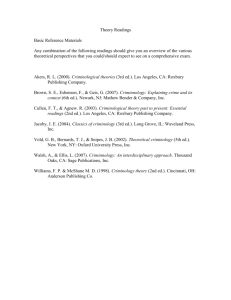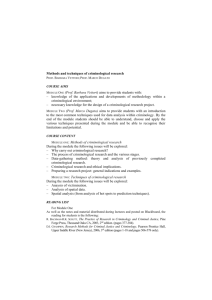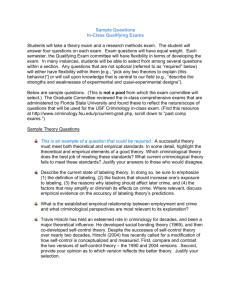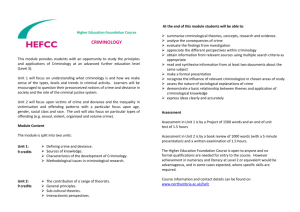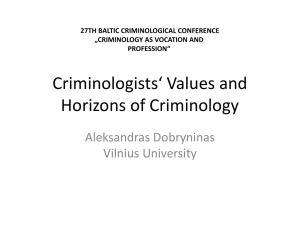REVIEW NOTES ON CRIMINOLOGICAL RESEARCH AND
advertisement
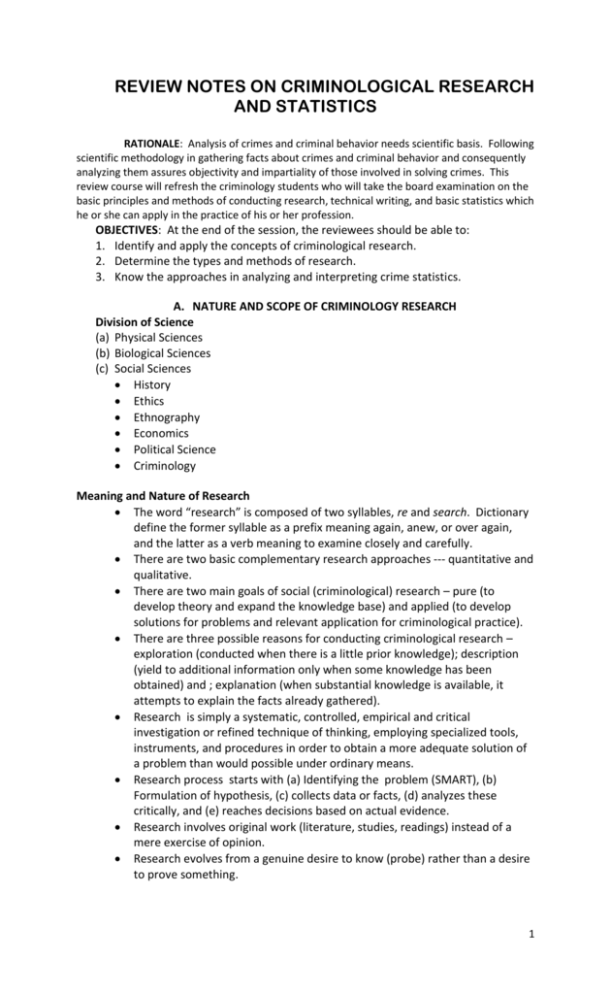
REVIEW NOTES ON CRIMINOLOGICAL RESEARCH AND STATISTICS RATIONALE: Analysis of crimes and criminal behavior needs scientific basis. Following scientific methodology in gathering facts about crimes and criminal behavior and consequently analyzing them assures objectivity and impartiality of those involved in solving crimes. This review course will refresh the criminology students who will take the board examination on the basic principles and methods of conducting research, technical writing, and basic statistics which he or she can apply in the practice of his or her profession. OBJECTIVES: At the end of the session, the reviewees should be able to: 1. Identify and apply the concepts of criminological research. 2. Determine the types and methods of research. 3. Know the approaches in analyzing and interpreting crime statistics. A. NATURE AND SCOPE OF CRIMINOLOGY RESEARCH Division of Science (a) Physical Sciences (b) Biological Sciences (c) Social Sciences History Ethics Ethnography Economics Political Science Criminology Meaning and Nature of Research The word “research” is composed of two syllables, re and search. Dictionary define the former syllable as a prefix meaning again, anew, or over again, and the latter as a verb meaning to examine closely and carefully. There are two basic complementary research approaches --- quantitative and qualitative. There are two main goals of social (criminological) research – pure (to develop theory and expand the knowledge base) and applied (to develop solutions for problems and relevant application for criminological practice). There are three possible reasons for conducting criminological research – exploration (conducted when there is a little prior knowledge); description (yield to additional information only when some knowledge has been obtained) and ; explanation (when substantial knowledge is available, it attempts to explain the facts already gathered). Research is simply a systematic, controlled, empirical and critical investigation or refined technique of thinking, employing specialized tools, instruments, and procedures in order to obtain a more adequate solution of a problem than would possible under ordinary means. Research process starts with (a) Identifying the problem (SMART), (b) Formulation of hypothesis, (c) collects data or facts, (d) analyzes these critically, and (e) reaches decisions based on actual evidence. Research involves original work (literature, studies, readings) instead of a mere exercise of opinion. Research evolves from a genuine desire to know (probe) rather than a desire to prove something. 1 Ethical Considerations in Research Veracity/Accurate Analysis and Reporting (obligation to tell the truth, not to lie or deceive others) Privacy (obligation to maintain the state or condition of limited access to a person) Anonymity and Confidentiality (obligation not to divulge information discovered without the permission of the subject) Fidelity (obligation to remain faithful to one’s commitments, which includes keeping promises and maintaining confidentiality) Informed consent (seeking permission to the person/guardian) No Harm (obligation not to inflict harm/endanger either physical or psychological or socially) Voluntary Participation Avoiding Deception ( reveal real purpose of the research) B. RESEARCH METHODS Methods in Criminological Research 1. Descriptive method (to describe systematically a situation or area of interest factually and accurately) 2. Historical method (to reconstruct the past objectively and accurately, often in relation to the tenability of a hypothesis) 3. Case and Field method (to study intensively the background, current status, and environmental interactions of a given social unit) 4. Correlational method (to investigate the extent to which variations in one factor correlate with variations in one or more other factors based on correlation coefficient) 5. Causal-comparative or “Ex post facto” method (to investigate possible causeand- effect relationships by observing some existing consequences and looking back through the data for plausible causal factors) 6. Experimental method (to investigate possible cause-and-effect relationship between two or more treatment conditions and comparing the results to a control group(s) not receiving the treatment; “What will happe n”) Types of Criminological Research 1. Action Research (to develop new skills or new approaches and to solve problems with direct application to the workplace or other applied setting) 2. Survey (descriptive) Research (to know of interest “what is”; typically employs questionnaires and interviews to determine attitudes, opinions, preferences, and perceptions of interest to the researcher) Close-ended Questionnaire (pre-categorized by the researcher’s words) Open-ended Questionnaire (in respondent’s words) 3. Observational Research (collecting direct information about human behavior) 4. Historical Research (investigating documents and other sources that contains facts that existed in the past; “What was”) 5. Evaluation Research (to study processes and procedures for the improvement of a system) Types of Criminological Research According to Purpose 1. Exploration (to develop an initial, rough understanding of a phenomenon) Methods: literature reviews, interviews, case studies, key informants 2 2. Description (precise measurement and reporting of the characteristics of the population or phenomenon) Methods: census, surveys, qualitative studies 3. Explanation (why “Is x the case?” or “Is x the relationship?”) Methods: experimental Variables are the conditions or characteristics that the researcher manipulates, controls, or observes. (Independent Variable, Dependent Variable, Moderator Variable) Hypothesis (“wise guess”) Null hypothesis; alternative hypothesis (operational hypothesis) Sources of information 1. Related Literature (books, magazine) 2. Related Reading (legal documents, memos) 3. Related Studies (journals, thesis, dissertation) 4. Key informants 5. Artifacts 6. Other material evidences C. WRITING THE RESEARCH REPORT APA format makes use of parenthetical citation (old format use latin citations – ibid; op. cit ; or loc cit and endnotes or footnotes) PARTS OF A RESEARCH PAPER (THESIS) A. Preliminary Pages Cover page Approval Sheet Abstract Table of Contents List of Tables Chapter 1 Introduction Background of the Study (includes significance of the study) Conceptual framework The Problem and hypotheses) Chapter 2 Method and Procedures Research design Population (includes scope and delimitation of the study) Data-gathering procedures Data gathering tools (includes the description of the research instruments, Validity and Reliability of the instruments) Statistical tools Chapter 3 Interpretation and Analysis of Findings Presentation of data Analysis and Interpretation Drawing implications out of the research findings Corroboration from related sources of information Chapter 4 Conclusions and Recommendations B. Appendices (References, forms/tools. Curriculum Vitae) 3 D. STATISTICS Sampling refers to the method of choosing subjects in a particular study. There are two basic approaches to sampling: Probability (systematic; randomized) and Non probability sampling) 1. Probability sampling (simple random, stratified random, cluster, systematic-intervals) 2. Nonprobability (convenience, quota, purposive or judgmental, snow-ball) Levels of Measurement (a process that employs rules to assign numbers to phenomena) Nominal (observations are categorized or sorted based on defined properties; each category is distinct, mutually exclusive, and exhaustive. Ex. Gender, Religious Affiliation, College major, hair color, birthplace, nationality, tribe) Ordinal (scores or observations are ranked in order without distance between individuals. Ex. Age group when ranked, Socio-Economic-Status, Level of Conflict) Interval (with equal intervals between numbers where there is no absolute absence of the attribute because zero is assigned and represents an arbitrary point. Ex. Temperature, IQ score) Ratio (this is in contrast to interval where there exist an absolute absence of the attribute or rational zero. Ex. Age, height, weight, length of time) Common Statistical Tools For sample size, Slovin’s ; Parten’s Formula For reliability test, split-half method; Spearman-brown prophesy. Cronbach’s coefficient alpha For the test of validity: standardized tool; pass through the panel of experts; used in other studies. Sources of Measurement Errors Environmental factors Researcher factors Instrumentation factors Subject factors Two categories of Quantitative Data Analysis Descriptive Statistics. These Statistical methods which summarize, organize, and describe data, providing an organized visual presentation of the data collected. Ex. Measures of central tendencies (Mean, median mode) and measures of variability (range, interquartile range, variance, semi-quartile range, and standard deviation) Inferential Statistics. These are statistical techniques used to estimate or predict a population parameter from a sample statistic. 4
